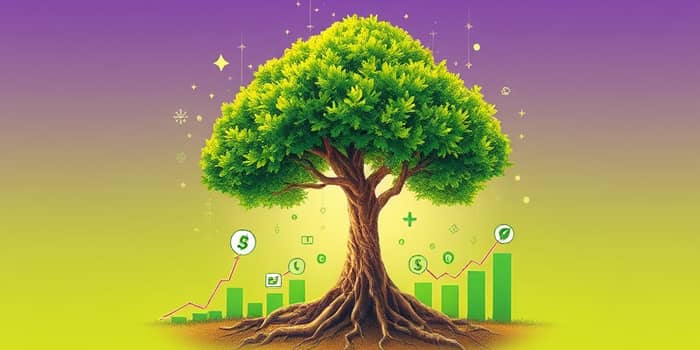
In an era where profit alone no longer defines success, investors seek ways to align their financial goals with meaningful change. Sustainable wealth emerges as the new beacon for those who aim to grow assets while supporting society and the environment.
Sustainable wealth means building and preserving assets over the long term with strategies that impact the planet and its people. It merges traditional financial metrics with Environmental, Social, and Governance (ESG) considerations, creating a framework that values both returns and responsibility.
The core pillars—people, planet, profit, and purpose—drive a holistic approach, often called the quadruple bottom line. By evaluating companies through these lenses, investors can foster ethical leadership and accountability while aiming for competitive returns.
ESG investing integrates non-financial factors into investment decisions. It has grown rapidly, with U.S. sustainable assets hitting $8.4 trillion in 2022. Despite a dip from $17.1 trillion in 2020 due to anti-greenwashing regulations, the demand for genuine sustainable opportunities remains robust.
This approach encourages investors to support companies that are better prepared for regulatory shifts, climate risks, and evolving consumer expectations.
Data consistently shows that sustainable funds often match or exceed the performance of traditional investments. Over a ten-year span, 58.8% of sustainable funds outperformed their peers. The JUST U.S. Large Cap Diversified Index delivered an annualized return of 15.94%, surpassing the Russell 1000’s 14.76%.
Moreover, sustainable funds tend to exhibit lower downside risk during market turbulence, as evidenced in the financial crises of 2008, 2015, and the 2020 pandemic. Integrating ESG factors helps avoid companies prone to reputational or regulatory setbacks.
More than 54% of global firms now include ESG in their risk reporting, signaling a shift toward proactive risk management. Investors who prioritize these metrics often uncover hidden opportunities and mitigate unforeseen liabilities.
Creating sustainable wealth requires disciplined habits and forward-looking strategies. Here are essential principles to guide your journey:
By committing to these practices, investors can build resilience against market volatility and align their portfolios with evolving global challenges.
Beyond financial gains, sustainable investments generate measurable impact. Allocations to clean energy projects can reduce carbon emissions, while social impact bonds fund community development initiatives. Investors play a vital role in advancing the United Nations Sustainable Development Goals and upholding the Paris Agreement objectives.
For instance, funding clean water innovations in developing regions not only delivers potential returns but also fosters social progress and equity. By directing capital toward meaningful solutions, investors become catalysts for positive change.
Constructing an authentic sustainable portfolio involves careful research and due diligence. Consider these asset types and evaluation steps:
To avoid greenwashing, seek investments with third-party certifications and clear impact metrics. Regularly review portfolio holdings, engage with company management on ESG practices, and adjust allocations as transparency standards evolve.
Investors who embrace sustainability often enjoy enhanced reputation and trust among stakeholders. Companies with robust ESG profiles attract top talent, foster customer loyalty, and can gain market share. At the same time, portfolios grounded in ESG principles may experience smoother performance during economic downturns, thanks to their diversified and forward-thinking nature.
Financial institutions increasingly view sustainable wealth management as a competitive advantage, offering clients both financial performance and a sense of purpose that resonates with modern values.
Despite its promise, sustainable investing faces hurdles. Greenwashing remains a threat, as some firms exaggerate their ESG credentials. Measurement of social and environmental outcomes is still evolving, requiring standardized benchmarks and reliable data sources.
Regulatory landscapes are tightening, pushing asset managers to substantiate their sustainability claims. As transparency improves and impact reporting matures, investors will gain greater confidence in their sustainable allocations.
Sustainable wealth represents a paradigm shift in finance—one where profit and purpose go hand in hand. By adopting ESG principles, investors can achieve long-term financial success while driving positive societal and environmental outcomes.
Start by defining your values, selecting credible investment vehicles, and maintaining financial discipline. Embrace this holistic approach to not only grow your assets but also leave a lasting legacy for generations to come.
References













